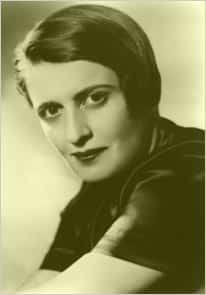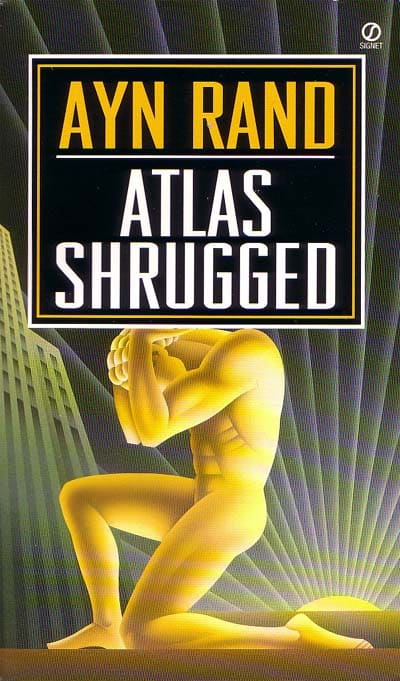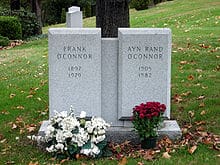The woman who would become Ayn Rand was born Alice Rosenbaum on February 2, 1905. (Branden, Barbara pg.3 1986). She was born during the eleventh year of Nicholas II’s reign in Russia.(Baker pg.1 1987). Rand’s birth was just before a revolution in Russia, however this revolution was put down by her first year.(Branden, Barbara pg.3 1986). The Rosenbaum’s lived quite comfortably under the czar.(Baker pg.1 1987).
Beneath their large apartment was Fronz Rosenbaum’s chemist shop.(Branden, Barbara pg. 4 1986). Rand’s father was a serious man whom  she never knew very well.(Branden, Barbara pg.4 1986). Ayn’s mother, Anna Rosenbaum, was the opposite of her father and was very sociable. (Branden, Barbara pg. 4-5 1986). As a child, Rand did not have a true sense of affection with her father. (Branden, Barbara pg.5 1986). However, she did develop a strong bond of love with him as she grew older. (Branden, Barbara pg. 4 1986). Ayn did not get along well with her mother. (Branden, Barbara pg.5 1986). Although the Rosenbaum family was traditionally Jewish, it is said that Rand really did not have a religious upbringing. (Baker pg.2 1987). As a result, she became atheist as a child after coming to the conclusion that believing in God is degrading to humans in the sense that man should live for no one else but himself. (Baker pg.3 1987). Rand discovered a passion for upbeat, lively music which she began collecting on records. (Branden, Barbara pg.8 1986). By the time she was five years of age, she had two little sisters, Natasha and Elena. (Branden, Barbara pg.7 1986). As a whole, Ayn’s childhood was not a pleasant experience for her; in later years it proved to be an unhappy memory as well. (Branden, Barbara pg.34 1986). Ayn Rand received a good education and learned to read and write at age six. (Baker pg.2 1987).
she never knew very well.(Branden, Barbara pg.4 1986). Ayn’s mother, Anna Rosenbaum, was the opposite of her father and was very sociable. (Branden, Barbara pg. 4-5 1986). As a child, Rand did not have a true sense of affection with her father. (Branden, Barbara pg.5 1986). However, she did develop a strong bond of love with him as she grew older. (Branden, Barbara pg. 4 1986). Ayn did not get along well with her mother. (Branden, Barbara pg.5 1986). Although the Rosenbaum family was traditionally Jewish, it is said that Rand really did not have a religious upbringing. (Baker pg.2 1987). As a result, she became atheist as a child after coming to the conclusion that believing in God is degrading to humans in the sense that man should live for no one else but himself. (Baker pg.3 1987). Rand discovered a passion for upbeat, lively music which she began collecting on records. (Branden, Barbara pg.8 1986). By the time she was five years of age, she had two little sisters, Natasha and Elena. (Branden, Barbara pg.7 1986). As a whole, Ayn’s childhood was not a pleasant experience for her; in later years it proved to be an unhappy memory as well. (Branden, Barbara pg.34 1986). Ayn Rand received a good education and learned to read and write at age six. (Baker pg.2 1987).
She found her classes boring and too easy. (Baker pg.2 1987). This led her to begin writing simple short stories and novels. (Baker pg.2 1987). Rand’s inability to fit in socially at school and her boredom with the education she was receiving led her to become somewhat of a recluse with one exception: her passion for literature. (Branden, Barbara pg.11 1986). Literature seemed to absorb Ayn more than any other thing; it intrigued her and gave her much pleasure to read and soon, to write. (Branden, Barbara pg.11 1986). “She would sit in school, barricaded behind a book, scribbling furiously at her latest adventure, wanting only to be alone, to write, to devise dangerous exploits for her characters.” (Branden, Barbara pg.11 1986). Rand’s decision to become a writer became certain at age nine. (Baker pg.2 1987). The decision was made while walking down a London street that she would devote her life to writing. (Branden, Barbara pg.14 1986). When the great war in Russia began, Ayn started writing stories with “the intensity that the times demanded”. (Baker pg.2 1987). Rand enrolled herself in a university at Petrograd, previously known as St. Petersburg and her place of birth, at age sixteen. (Baker pg.3 1987). Although she did not write any creative, fictional works during her years at the university, an outline for a play was later used as inspiration for her novel, Anthem. (Baker pg.3 1987). Rand read many literary works while she was at the university and gained a lot of knowledge from them. (Baker pg.3 1987).
Ayn Rand graduated the university in 1924. (Baker pg.4 1987). In 1926, Ayn Rand celebrated her twenty-first birthday. (Baker pg.4 1987). However, she did not feel that it was her twenty-first birthday, to her it signified the beginning of her life. (Branden, Barbara pg.62 1986). Rand arrived in New York on a February evening at seven o’ clock p.m. (Branden, Barbara pg.63 1986). She had with her only fifty dollars in her pocket, a typewriter in her arms, stories etched in her mind and “the sense of life as exaltation.” (Branden, Barbara pg.63 1986). From New York, Rand went on to Chicago to stay with some relatives there. (Baker pg.5 1987). Ayn disliked Chicago very much and went straight to work on writing scenarios and film ideas. (Branden, Barbara pg.69 1986). Over this summer in Chicago, Rand worked to improve her English, wrote manuscripts and her film ideas. (Baker pg.5 1987). She was ecstatic to finally be free and to be able to achieve all the things she had always wanted. (Branden, Barbara pg.71 1986). At the end of the summer in Chicago, Rand set out for Hollywood with only her manuscripts and a recommendation from DeMille’s Chicago Distributors to the Cecil B. DeMille Studio in Hollywood. (Baker pg.5 1987). Ayn’s relatives sent her off with a train ticket and one-hundred dollars. (Branden, Barbara pg.73 1986). She was ready to go out on her own and truly begin her life. (Branden, Barbara pg.73 1986). Alice Rosenbaum re-named herself Ayn after a Finnish writer she adored. (Baker pg.4 1987). It appealed to her because Ayn rhymed with mine and promised she would be recognized and admired. (Baker pg.4 1987). Rand came from her “Remington-Rand” typewriter. (Baker pg.4 1987).
Ayn decided this name sounded more American than Alice Rosenbaum. (Baker pg.4 1987). Furthermore, it signified new-life and a relief from Russia’s system. (Baker pg.4 1987). Lastly, Ayn did not want to endanger the lives of her relatives in communist-Russia by her anti-communist feelings. (Branden, Barbara pg.72 1986). Ayn Rand moved into a room at the new Studio Club which was a “…haven for young aspirants come to conquer Hollywood…” and housed many actresses, dancers, studio clerks and the like. (Branden, Barbara pg.73 1986). On her first day looking, Ayn found a job working at the DeMille Studio. (Baker pg.5 1987). Rand was hired as an extra at the studio for seven dollars and fifty cents a day which seemed to be a fortune to her. (Branden, Barbara pg. 77 1986). She worked for DeMille for nine years until his studio closed and remained in Hollywood for nine more years. (Baker pg.5 1987). Ayn Rand met what was to become her future husband after her second week in Hollywood; his name was Frank O’ Connor. (Branden, Barbara pg.79 1986). Rand says her feelings for O’ Connor were love at first sight. (Branden, Barbara pg.80 1986). They were great companions and were married in 1929. (Baker pg.6 1987). Because she was now married to an American citizen, Ayn applied for citizenship and was naturalized in 1931. (Baker pg.7 1987). The two remained married for fifty years until O’ Connor’s death in 1979. (Baker pg.6-7 1987).
Rand began working in the wardrobe department of R.K.O. studios in the summer of 1929. (Baker pg.7 1987). She began writing We The  Living, which was published in 1936. (Baker pg.7 1987). “With the Hollywood success under her belt, Rand felt confident to take on Broadway…”(Baker pg.9 1987). Her play, Night of January 16th was a great success and ran for seven months. (Baker pg.9 1987). Ayn spent six years writing her next novel, The Fountainhead. (Baker pg.11 1987). In late 1935, Rand was finally able to devote all of her time to writing The Fountainhead. (Branden, Barbara pg.36 1986). At long last, in December of 1942, Rand completed The Fountainhead, (Branden, Barbara pg.174 1986), and the book was published in 1943.(Baker pg.13 1987). Atlas Shrugged was to be Ayn Rand’s next novel. (Baker pg.17 1987). She was aware that it would take awhile to be accepted but that eventually, Atlas Shrugged would have an influence. (Branden, Barbara pg.294 1986). Atlas Shrugged is a philosophical novel which began with the question: “What if all the creative minds of the world went on strike?” (Branden, Nathaniel pg.79-80 1989). When it came time to find a publisher for Atlas Shrugged, Rand wanted to make sure that, because of the controversy her book would inevitably cause, the publisher would stand by her. (Branden, Barbara pg.294 1986). Finally, the book was published by Random House Publishers on October 10, 1957. (Baker pg.17 1987). “Rand supporters and critics alike agree that this is the essence of her philosophy of life, politics and economics.” (Baker pg.17 1987).
Living, which was published in 1936. (Baker pg.7 1987). “With the Hollywood success under her belt, Rand felt confident to take on Broadway…”(Baker pg.9 1987). Her play, Night of January 16th was a great success and ran for seven months. (Baker pg.9 1987). Ayn spent six years writing her next novel, The Fountainhead. (Baker pg.11 1987). In late 1935, Rand was finally able to devote all of her time to writing The Fountainhead. (Branden, Barbara pg.36 1986). At long last, in December of 1942, Rand completed The Fountainhead, (Branden, Barbara pg.174 1986), and the book was published in 1943.(Baker pg.13 1987). Atlas Shrugged was to be Ayn Rand’s next novel. (Baker pg.17 1987). She was aware that it would take awhile to be accepted but that eventually, Atlas Shrugged would have an influence. (Branden, Barbara pg.294 1986). Atlas Shrugged is a philosophical novel which began with the question: “What if all the creative minds of the world went on strike?” (Branden, Nathaniel pg.79-80 1989). When it came time to find a publisher for Atlas Shrugged, Rand wanted to make sure that, because of the controversy her book would inevitably cause, the publisher would stand by her. (Branden, Barbara pg.294 1986). Finally, the book was published by Random House Publishers on October 10, 1957. (Baker pg.17 1987). “Rand supporters and critics alike agree that this is the essence of her philosophy of life, politics and economics.” (Baker pg.17 1987).
Although Atlas Shrugged was reviewed negatively for the most part, it sold extremely well, with sales of 125,000 in just the first year. (Baker pg.17 1987). “Whether it [Atlas Shrugged] takes its place as a classic piece of American fiction or is judged merely a huge burst of ideological wind depends on the taste of future generations.”(Baker pg.64 1987). Ayn Rand referred to Atlas Shrugged as her finest novel, it was the largest at 1,168 pages and took her nine years to complete. (Baker pg.58 1987). Atlas Shrugged has become “the holy text of the objectivist movement.” (Baker pg.63 1987). From Atlas Shrugged, Ayn Rand was able to present the essence of her philosophy, Objectivism. (Ayn Rand column). This book became her last novel of fiction because by 1958 she had become a philosopher. (Baker pg.17 1987). In 1961, Ayn published her first non-fiction philosophic novel, For The New Intellectual. (Baker pg.19 1987). In 1962, Ayn Rand began the Objectivist Newsletter, in which she was able to further her influence of Objectivism. (Baker pg.20 1987). The four basics of Objectivism are: Objective Reality, Reason, Self-interest, and Capitalism. (Ayn Rand Column).
Objectivism is against altruism which “…holds that man has no right to exist for his own sake, that service to others is the only moral justification of his existence…” (Ayn Rand Column). During the height of the Objectivist movement in 1968, Rand had gathered a very devoted group of followers and believers of her philosophy. (Baker pg.22 1987). The motto that these followers lived by was: “I swear–by my life and my love of it–that I will never live for another man nor ask another man to live for mine.” (Baker pg.22 1987). Between the years of 1970-1971, Ayn Rand published four more books on her philosophy: The Virtue of Selfishness, Capitalism: The Unknown Ideal, The Romantic Manifesto: A Philosophy of Literature and The New Left: The Anti-Industrial Revolution. (Baker pg.22 1987 and Branden, Barbara pgs. 324-325 1986). Rand expresses the controversy of education given by the government. (Ayn Rand Column). Education is said to be extremely important by the government and the government plans on spending millions of tax dollars under new programs for education. (Ayn Rand Column). On the contrary, many families who pay taxes cannot afford to send their children to college, and they are not allowed to take away educational costs from their taxes. (Ayn Rand Column). Rand believed that the American school system is like the situation brought up in Victor Hugo’s, The Man Who Laughs. (Baker pg.90 1987). “It is a story about a society that kept children in oddly shaped pots until they were so monstrously stunted and deformed that they could be used to entertain dignitaries.” (Baker pg.90 1987). Rand felt this action is similar to that of nursery schools, where children are taught to play fairly, and not to use imaginary or conceptual skills. (Baker pg.90 1987).
In addition, it continues in higher grades and even in college. (Baker pg.90 1987). Students are taught at these levels that ” the human mind is  incapable of knowing anything for certain.” (Baker pg.90 1987). “….young Americans are so intellectually mutilated that they are incapable of identification…” (Baker pg.90 1987). The tormentors are the “…Kantian professors who train teachers to suppress individuality in children, who demonstrate by their own lives that knowledge is beyond the grasp of the human mind.” (Baker pg.90 1987). Ayn Rand died on March 6, 1982 at the age of seventy eight. (Baker pg.28 1987 and Branden, Nathaniel pg.1 1989). Her health had been rapidly deteriorating for a few months prior to her death; she had developed cardio-pulmonary problems. (Branden, Nathaniel pg.1 1989). Ayn was buried next to her husband, Frank O’ Connor, at the Kensico Cemetery in Valhalla, New York. (Baker pg.28 1987). “Ayn had begun life with a single passionate goal–to create her ideal world and her ideal man. And at the end of her life–despite the odds against her, despite the pain and the losses, despite the illness and anguish and death–it was done.” (Branden, Barbara pg.404 1986). “It’s a benevolent universe, and I love it, and any struggle was worth it. Struggle or unhappiness are so enormously unimportant. I don’t regret a minute of my life.” (Branden, Barbara pg.404 1986 [said by Ayn Rand]).
incapable of knowing anything for certain.” (Baker pg.90 1987). “….young Americans are so intellectually mutilated that they are incapable of identification…” (Baker pg.90 1987). The tormentors are the “…Kantian professors who train teachers to suppress individuality in children, who demonstrate by their own lives that knowledge is beyond the grasp of the human mind.” (Baker pg.90 1987). Ayn Rand died on March 6, 1982 at the age of seventy eight. (Baker pg.28 1987 and Branden, Nathaniel pg.1 1989). Her health had been rapidly deteriorating for a few months prior to her death; she had developed cardio-pulmonary problems. (Branden, Nathaniel pg.1 1989). Ayn was buried next to her husband, Frank O’ Connor, at the Kensico Cemetery in Valhalla, New York. (Baker pg.28 1987). “Ayn had begun life with a single passionate goal–to create her ideal world and her ideal man. And at the end of her life–despite the odds against her, despite the pain and the losses, despite the illness and anguish and death–it was done.” (Branden, Barbara pg.404 1986). “It’s a benevolent universe, and I love it, and any struggle was worth it. Struggle or unhappiness are so enormously unimportant. I don’t regret a minute of my life.” (Branden, Barbara pg.404 1986 [said by Ayn Rand]).
Bibliography:
Branden, Barbara The Passion of Ayn Rand 1986 Bantam Doubleday Dell Publishing Group Inc. New York, N.Y. Nathaniel, Branden Judgement Day: My Years with Ayn Rand 1989 Houghton Mifflin Company Boston, Massachusetts James T. Baker Ayn Rand 1987 G.K. Hall and Co. Boston, Massachusetts The Ayn Rand Column: A Collection of her Weekly Newspaper Articles Written for the Los Angeles Times. With additional, little-known essays by Ayn Rand 1971, 1976, 1977, 1978, 1979, 1991 Second Renaissance Books Oceanside, CA

Saved me! Thank you!